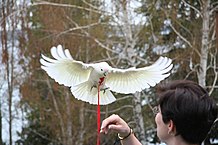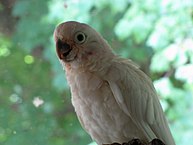Think you have a smart parrot? That may be, but a Goffin’s Cockatoo has recently set a new standard by which bird – and indeed animal – intelligence will be measured. Pipin, as the avian genius is known, demonstrated a skill previously known to exist only in chimpanzees. Using sequential problem solving abilities, Pipin (and, after a time, several of his “lab partners”) figured out how to open 5 different locks – each of which jammed the next lock, and each requiring a different physical maneuver – in order to obtain a treat. Mastering the task, which took nearly 2 hours, required the bird to solve problems, remember what he learned and apply it to a different task, and focus on a distant reward…and, I assume, to have patience!
The Experiment
The fascinating research into Psittacine intelligence was conducted at the University of Vienna, and published in the journal PLoS ONE (8(7): e68979;doi: 10.1371/journal.pone.oo68979; 7/13). Ten Goffin’s Cockatoos were presented with a box containing a treat. The door to the box was transparent, so that the birds could see the treat (a nut) within, and was secured by 5 locks.
Lock number 1 had to be opened before the cockatoos could get to lock number 2, which had to be opened in order to gain access to lock number 3, and so on. Opening each lock required a different physical action – removing a pin, screw and bolt, turning a wheel and shifting a latch.
Without prior training, Pipin opened the box in less than 2 hours. The article stressed the speed of his problem solving, which of course is impressive. But I’m equally surprised by the fact that he could keep at a problem for such a long time. As anyone who has tried to train parrots (or toddlers!) knows, their attention spans are relatively short (or so I thought…maybe birds and 2-year-old children have been tricking me all along!).
Five other “less-cerebrally-gifted” but still quite intelligent Goffin’s Cockatoos solved the puzzle after watching Pipin perform or following exposure to each lock individually.
Researchers Make the Test More Difficult
Sequential problem solving requires a parrot or person to remember and then apply what has been learned, and to work for a distant reward. In order to test these and related abilities, the University of Vienna researchers scrambled the locks, so that number 3 was first in line, followed by number 5, etc. Once a cockatoo had mastered a lock, it rarely became confused if the lock’s place in the puzzle was changed. And locks that were disabled by the researchers (left unlocked) were given a quick glance and then ignored.
How Bright is Your Parrot?
I’ve spent a lifetime working with parrots and other animals, yet never fail to be amazed by stories of learning abilities relayed to me by readers and zoo visitors. Please be sure to post your own “smart bird” tales below!
Further Reading
Kea Intelligence Shocks Researchers http://blogs.thatpetplace.com/thatbirdblog/2011/06/24/kea-parrot-intelligence-shocks-researchers/#.U7AokrEnUpo
African Gray Parrot Wins Talking Contest and Lands Movie Role http://blogs.thatpetplace.com/thatbirdblog/2011/02/22/african-grey-parrot-wins-international-talking-contest%E2%80%A6and-a-movie-role/#.U7Ao3LEnUpo
Sequential Problem Solving in Goffin’s Cockatoos (Original Article) http://www.plosone.org/article/info%3Adoi%2F10.1371%2Fjournal.pone.0068979
 That Bird Blog – Bird Care and History for Pet Birds
That Bird Blog – Bird Care and History for Pet Birds



